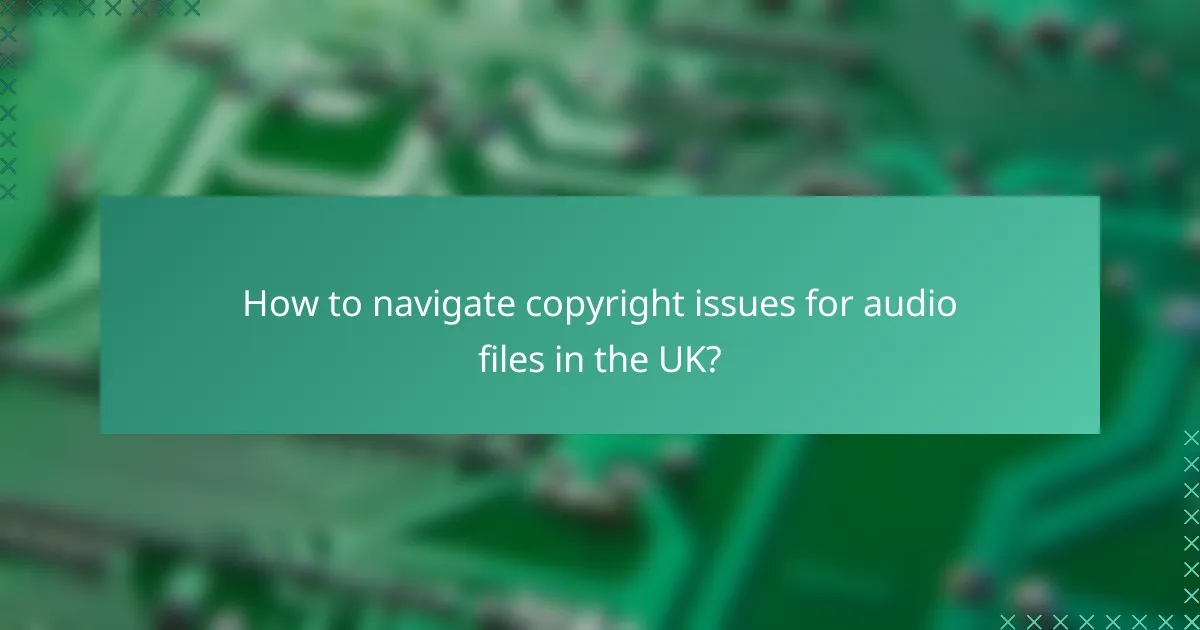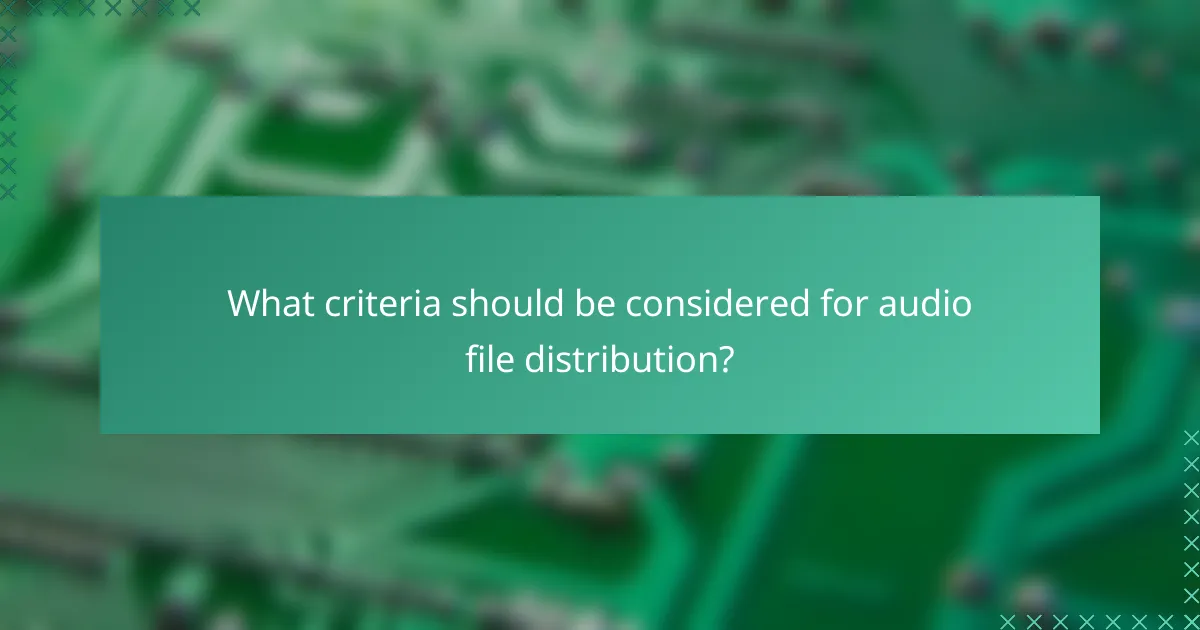Audio files require meticulous quality control to ensure high production standards, utilizing effective editing tools and robust testing protocols. Proper distribution strategies, including platform selection and format optimization, are vital for reaching audiences while adhering to copyright regulations. Understanding the legal landscape surrounding audio copyrights is essential for creators to protect their work and navigate licensing requirements effectively.

How to ensure audio file quality control in the UK?
Ensuring audio file quality control in the UK involves using effective editing tools, implementing robust quality assurance protocols, and conducting regular testing. These steps help maintain high standards for audio production, which is crucial for both professional and personal projects.
Use of audio editing software
Utilizing reliable audio editing software is essential for maintaining audio quality. Popular options in the UK include Adobe Audition, Audacity, and Logic Pro, each offering various features for editing, mixing, and mastering audio files. Choose software that fits your needs, whether for simple edits or complex productions.
When selecting audio editing software, consider factors like user interface, supported file formats, and available plugins. A good choice can streamline your workflow and enhance the overall sound quality of your projects.
Implementing quality assurance protocols
Quality assurance protocols are vital for ensuring consistent audio quality. Establish a checklist that includes steps such as verifying file formats, checking for noise or distortion, and ensuring proper volume levels. This can help identify issues before final distribution.
Incorporating peer reviews or feedback sessions can also enhance quality assurance. Having multiple sets of ears listen to the audio can catch problems that one person might miss, leading to a more polished final product.
Regular audio file testing
Regular testing of audio files is crucial for maintaining quality over time. Schedule periodic reviews of your audio files to check for degradation or issues that may arise from file compression or format changes. This is especially important for archived files.
Consider using a range of playback devices during testing, such as headphones, speakers, and mobile devices. This ensures that the audio maintains its quality across different platforms, which is essential for effective distribution in the UK market.

What are the best practices for audio file distribution?
Effective audio file distribution involves using the right platforms, optimizing formats, and promoting content through social media. These practices ensure that your audio reaches the intended audience while maintaining quality and compliance with copyright regulations.
Utilizing digital distribution platforms
Digital distribution platforms are essential for getting your audio files to listeners. Services like Spotify, Apple Music, and SoundCloud allow creators to upload their content easily and reach a global audience. Choose a platform that aligns with your target demographic and offers favorable revenue-sharing models.
When selecting a platform, consider factors such as user base, ease of use, and analytics tools. Some platforms may charge a fee or take a percentage of your earnings, so evaluate these costs against potential exposure and revenue.
Optimizing file formats for streaming
Choosing the right file format is crucial for streaming quality and compatibility. Common formats include MP3, AAC, and WAV, each with its own advantages. For instance, MP3 is widely supported and offers a good balance between quality and file size, while WAV provides higher fidelity but larger file sizes.
When preparing audio files, aim for a bitrate of at least 128 kbps for streaming to ensure decent sound quality. Additionally, consider the target platform’s specifications and optimize your files accordingly to avoid playback issues.
Leveraging social media for promotion
Social media is a powerful tool for promoting audio content and engaging with your audience. Platforms like Instagram, Twitter, and Facebook allow you to share snippets, behind-the-scenes content, and links to your audio files. Use eye-catching visuals and hashtags to increase visibility and attract listeners.
Engagement is key; interact with your audience through comments and messages to build a loyal following. Consider running targeted ads to reach specific demographics, which can enhance your promotional efforts and drive more traffic to your audio files.

How to navigate copyright issues for audio files in the UK?
Navigating copyright issues for audio files in the UK involves understanding the legal protections for original works and ensuring compliance with licensing requirements. It’s essential to know your rights and obligations to avoid infringement and potential legal consequences.
Understanding copyright laws
Copyright laws in the UK protect original audio works, granting creators exclusive rights to reproduce, distribute, and perform their music. These rights typically last for the life of the creator plus 70 years, after which the work enters the public domain.
It’s crucial to recognize that using copyrighted music without permission can lead to legal action. Always verify whether a piece of music is protected before including it in any project, whether for commercial or personal use.
Obtaining necessary licenses
To legally use copyrighted audio files, you must obtain the appropriate licenses. This may involve contacting the copyright holder or their representative to negotiate terms, which can vary based on the intended use, such as broadcasting or streaming.
Common licenses include mechanical licenses for reproduction and synchronization licenses for pairing music with visual media. Be prepared to pay fees that can range from modest to significant, depending on the popularity of the music and the scope of its use.
Using royalty-free music
Royalty-free music offers a cost-effective alternative to traditional licensing, allowing you to use tracks without ongoing fees. However, it’s essential to read the terms of use carefully, as some royalty-free music may still have restrictions on commercial use or require attribution.
Many platforms provide royalty-free music, often categorized by genre or mood. Consider options like AudioJungle or Epidemic Sound, which offer a wide range of tracks for various projects, typically for a one-time fee or subscription model.

What tools can assist with audio file quality control?
Several tools can significantly enhance audio file quality control, ensuring that recordings meet professional standards. Key software options include iZotope RX for audio repair, Audacity for editing, and Waves plugins for enhancement.
iZotope RX for audio repair
iZotope RX is a powerful tool designed for audio repair and restoration. It offers features like noise reduction, click removal, and spectral editing, which can help eliminate unwanted sounds and artifacts from recordings.
When using iZotope RX, focus on the specific issues you want to address. For instance, if background noise is a problem, the Noise Reduction module can effectively reduce it without compromising the overall sound quality. Always preview changes to ensure the audio remains natural.
Audacity for editing
Audacity is a free, open-source audio editing software that provides a range of editing tools suitable for both beginners and professionals. It allows users to cut, copy, and paste audio segments, apply effects, and adjust levels easily.
To maximize Audacity’s potential, familiarize yourself with its interface and basic functions. For example, using the Equalization effect can enhance specific frequencies, improving clarity. Keep your project organized by labeling tracks and saving backups regularly.
Waves plugins for enhancement
Waves offers a variety of plugins that enhance audio quality through effects like compression, equalization, and reverb. These plugins can be integrated into most digital audio workstations (DAWs) to elevate the overall sound of your recordings.
When selecting Waves plugins, consider your specific needs. For instance, the Waves SSL G-Master Bus Compressor is popular for adding punch and cohesion to mixes. Experiment with different settings to find the right balance, and avoid over-processing, which can lead to a loss of dynamic range.

What criteria should be considered for audio file distribution?
When distributing audio files, it’s essential to consider factors such as target audience, platform compatibility, and the cost-effectiveness of distribution channels. These criteria help ensure that your audio content reaches the right listeners efficiently and economically.
Target audience analysis
Understanding your target audience is crucial for effective audio file distribution. Analyze demographics such as age, location, and listening habits to tailor your content and choose the right platforms. For instance, younger audiences may prefer streaming services, while older listeners might gravitate towards traditional radio or podcasts.
Conduct surveys or use analytics tools to gather insights about your audience’s preferences. This data can guide your marketing strategies and help you select the most suitable distribution channels.
Platform compatibility
Ensuring compatibility with various platforms is vital for successful audio distribution. Different platforms support different audio formats, so it’s important to convert your files into widely accepted formats like MP3 or WAV. This ensures that your content can be played on most devices without issues.
Additionally, consider the specific requirements of each platform, such as file size limits or metadata standards. Familiarize yourself with the guidelines of platforms like Spotify, Apple Music, or SoundCloud to optimize your audio files for each service.
Cost-effectiveness of distribution channels
Evaluating the cost-effectiveness of distribution channels can significantly impact your budget. Some platforms charge fees for hosting or distribution, while others may offer free services with limitations. Compare options based on your budget and the potential reach of each channel.
For example, using social media for promotion can be a low-cost strategy, while premium services may provide better analytics and reach but at a higher price. Weigh the benefits against the costs to find the best balance for your audio distribution needs.

What emerging trends are shaping audio file management?
Emerging trends in audio file management are increasingly influenced by advancements in technology and evolving consumer expectations. Key areas of focus include AI-driven tools for audio enhancement and a heightened emphasis on digital rights management to protect creators’ rights.
AI-driven audio enhancement tools
AI-driven audio enhancement tools are revolutionizing how audio files are processed and optimized. These tools utilize machine learning algorithms to improve sound quality, reduce noise, and even automate mixing processes, making them accessible for both professionals and amateurs.
Examples of popular AI audio enhancement tools include iZotope RX and Adobe Audition, which offer features like automatic audio repair and intelligent EQ adjustments. Users can expect improvements in audio clarity and consistency, often achieving results that would take significantly longer through traditional methods.
Increased focus on digital rights management
Digital rights management (DRM) has become a critical concern as the distribution of audio files expands across platforms. Enhanced DRM solutions help protect copyright holders by controlling how audio files are accessed and shared, preventing unauthorized use.
Content creators should consider implementing robust DRM strategies, such as watermarking and encryption, to safeguard their work. Additionally, staying informed about local regulations regarding copyright and DRM can help ensure compliance and protect intellectual property effectively.
